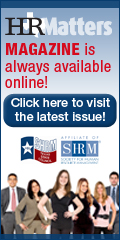
| Archives/Subscribe | Advertise | HR Matters | www.texasshrm.org |
Corporate Culture: Identifying the Behaviors that Define the Uniqueness or Corporations Classifying corporate culture by behavior style can improve organizational performance with enhanced candidate selection and enriched career development. In Part I of our series on corporate culture, we talked about four different types of culture: power culture, role culture, task culture, and person culture
Power Culture: Power culture depends on a central power source, such as the founder of the company. Individuals and relationships are emphasized over expertise and knowledge in the power culture. This is an environment of who you know, not what you know. The power culture is highly results-oriented but very abrasive. Gut instinct is used for decision making and few rules apply. Athletic organizations are an example of a power culture is
Role Culture: Role culture is also known as a process culture and can be highly bureaucratic as well as logical and rational. It is very procedural where managers and employees are careful to follow rules and regulations in a highly structured environment with very clear lines of leaderships. The role culture is reliable, stable and predictive but may not offer much creativity. An example of a role culture is a health services organization such as a hospital
Task Culture: Task cultures are typically found in high-risk types of environments such as explorative, developmental and project-oriented. Teams and task forces make - up the task culture where there is a great deal of creativity and cross-function. While the environment lacks stability, it offers excitement and opportunities to quickly build experience by serving in many roles. Task cultures are found in startups or exploratory operations, such as oil and gas ventures
Person Culture: A person culture is an individualistic type of culture. Employees have a great deal of autonomy and freedom with a key responsibility of serving other people. An individual's people skill is the preferred management style in this type of culture. A person culture can be found in universities and consulting firms
Research from Target Training International supports the fact that human behavior is broken down into four different categories: Dominant, Influential, Steadiness and Compliant. The combined categories are also popularly known as "DISC". Roots of the DISC behavior style date back to 1921 based on research conducted by psychologist C.G. Jung (Bonnstetter, 2001). The four behavior styles of DISC are described as follows: Dominant – ambitious, forceful, direct, independent, results - oriented and challenging. Influential – creative, expressive, enthusiastic, friendly, talkative, and stimulating. Steadiness – methodical, systematic, reliable, steady, relaxed, and modest. Compliant – logical, analytical, contemplative, conservative, exacting, careful, and deliberative (Bonnstetter, 2001). Comparing the DISC descriptors with the definition of the four culture styles, we find similarities. For example, power culture is results - oriented as in the dominant (D) behavior style, task culture is creative and exciting as in the influential (I) behavior style, person culture is reliable and stable as in the steadiness (S) behavior style and role culture is procedural and structured as in the compliant (C) behavior style. Therefore, we can connect the various cultures with the behavior styles of individuals or visa-versa. When using the DISC assessment to cross-reference individual with cultural behavior, applications for cultural enhancement emerge. For example, if an organization possesses a power culture which is results-oriented and abrasive, we can predict that someone who is personable, expressive and creative, such as the "I" behavior style, may not perform well in the power culture. Does that mean that this person isn't competent or capable? No. However, if our goal is to provide an environment of success (and it should be), then we may want to consider cross-referencing individual with cultural behavior to achieve optimum success at both the individual and organizational level. Therefore, we can conclude that behavior matching of culture and individuals is a valuable tool in career development and talent management. In the next part of our series we will further discuss the four behavior styles as well as assessing the environment as a key to individual and organizational success.
Reference: Bonnstetter, B., Suiter, J., Widrick, R. (2001). The Universal Language DISC, A Reference Manual. Target Training International, Ltd. Jones, P., & Robinson, P. (2012). Operations Management. Oxford: Oxford University Press.
Article submitted by MeLisa Rogers, PhD. MeLisa is a District Director for the Texas State Council of SHRM as well as charter/founding member of the South Texas SHRM Chapter. She is an independent higher education professional as well as a trainer / career coach through her firm Ultimate Career. |
|
P.O. Box 8058
Tyler, Texas 75711
www.texasshrm.org • info@texassshrm.org • 214-354-8740




